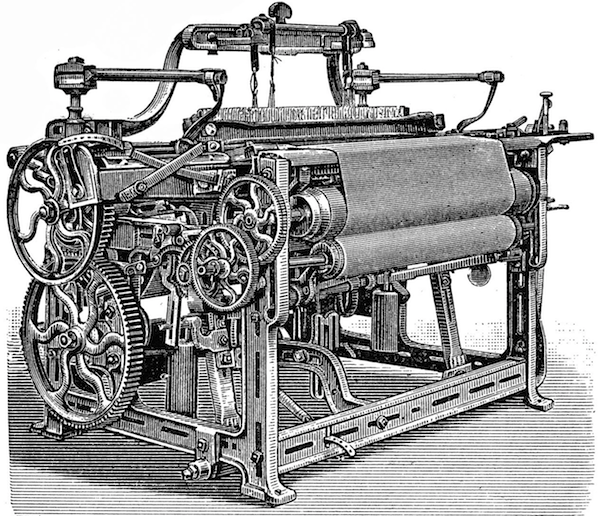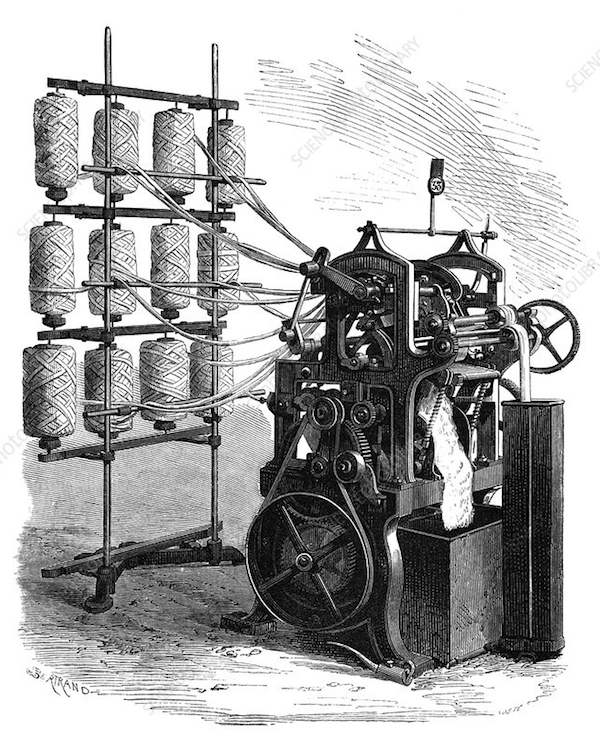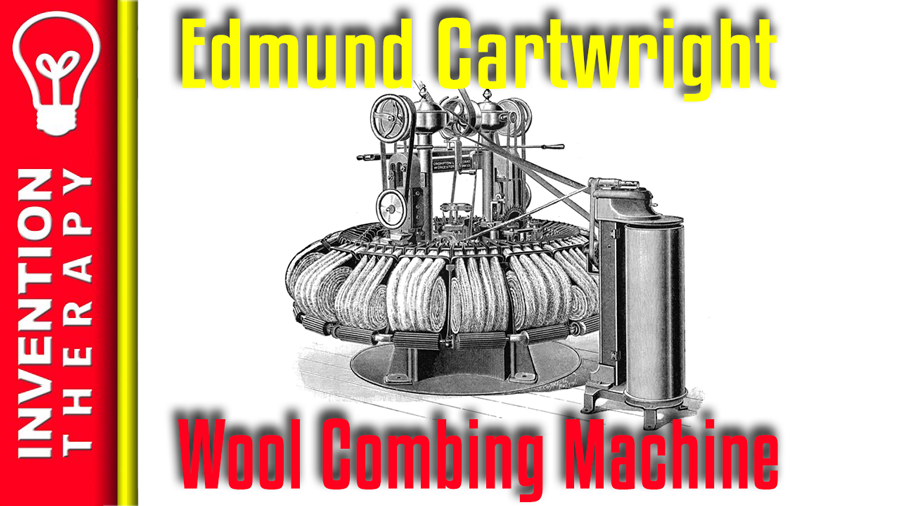Edmund Cartwright was an English inventor from the 18th century that invented the power loom and the wool combing machine. His achievements were essential contributions to the Industrial Revolution and the textile industry. Cartwright’s work was a progression from previous inventions and equipment such as John Kay’s flying shuttle.
His determination to contribute to the world saw him go from a clergyman to one of the most influential personalities from the 18th and early 19th centuries. Even though he was born into a wealthy family, Cartwright’s application and decisiveness to create something useful can be an inspiration to us all. In this article, we will take a look at Edmund Cartwright and the wool combing machine.

Who Was Edmund Cartwright?
If we want to dive deeper into the invention itself, we must first take a look at Edmund Cartwright himself. How did he come into the weaving industry? How and why did he go from being a clergyman to an inventor? Let’s find out.
Born to a Prominent Family
The Cartwright family was an influential family from Nottinghamshire, England. Edmund Cartwright was born on the 24th of April in 1743 to a landowner and a reverend, Edmund Cartwright senior. The parents were keen for their sons to get an education and become influential people. Edmund senior had five sons; three of them became famous.
Like his father, Edmund Cartwright Jr. set out to become a clergyman. He would have been one for the rest of his life, but a flash of enlightenment changed that in 1769. That is when Cartwright learned about some of the inventions in the weaving industry at the time. Edmund’s brothers went on to become influential people, too; John Cartwright, his older brother, was a political personality and a leader of the radicals that demanded changes within the Parliament. George, his other older brother, was a bit of an explorer. Primarily a trader, he became famous for exploring Labrador.
Edmund Cartwright was encouraged by his father to learn from an early age. The father wanted his sons to be ambitious and pursue big goals, and the investment paid off. Edmund received education from a young age. In his early childhood, he was mostly taught at home by his parents to read and write. When Edmund was a boy, his father paid some of the most exceptional tutors around to teach his son various topics – mathematics, engineering, grammar, and religious matters. Edmund entered the Queen Elizabeth Grammar School in Wakefield and was one of its brightest students.
An Aspiring Reverend
When Edmund was old enough, he would enroll in the University College in Oxford, one of the most renowned schools in the country and all over the world. Edmund was always a good learner, which he showed at the university level. As one of “good morals and dispositions” Cartwright Jr. was awarded a demyship. Later, he was enrolled by his father in the MA Magdalen College in Oxford, which he completed in 1766. His career looked to be a promising one, as he achieved top grades within his class.
In 1766, he got his first job as a rector of the Leicestershire Church, which was a relatively high position for someone at such a young age. It was looking like he would have a bright career as a reverend and not an inventor. He stayed at the Leicestershire Church for six years before moving to the church of Brampton to become a curate. From there, he moved to Lincoln in 1786 to be a prebendary.
Interest in Engineering Sparks Within Cartwright
Edmund Cartwright started taking an interest in engineering in his time as a scholar in Oxford, but it was not his primary ambition. He was determined to become a reverend instead. The clergyman became more seriously involved with engineering in his 30s when Edmund worked in Brampton and later in Lincoln. Cartwright had many interests and hobbies, and engineering was only one of them. He was also a part-time poet, and some of his poems were highly-acclaimed.
Cartwright became more involved with engineering in the 1780s. He knew a great deal about the textile industry at this time. He studied the industry in his spare time when he was not performing duties as a reverend. He was very much aware of the concepts of Arkwright’s spinning frame and Kay’s flying shuttle, and he became more interested in the weaving industry as a whole.
Cartwright saw a big opportunity in the textile industry. He thought that there was still space for improvement, especially in the automation of the machines. While the spinning frame of Arkwright contributed significantly towards mechanization of the weaving process, human workers still needed to provide input during the production of cloth. Cartwright knew that the human workforce was holding back the potential of the machines and that the workers were not able to keep up with increasing demand and the need for higher profits.
Since the invention of the spinning frame, Cartwright studied the design and other technologies within the industry. He had little to no knowledge before this and had to begin at the basics. His persistence is a testament to the power determination and what can is achievable even if you lack the knowledge and skills. Though Cartwright was an educated man, he had to learn everything from scratch. This process took him a lot of time and effort, but it eventually paid off.

Cartwright and the Power Loom
Before Edmund invented the Wool combing machine, he was involved in some projects that were significant for his establishment as one of the most famous engineers of his time. One such project was his concept of a power loom.
Cartwright always had the idea that the need for human workers limited the current spinning frames and that once Arkwright’s patent would expire, many small mills would begin pop up. The requirements for production would then increase as these new businesses grew. Cartwright saw the potential to make a profit, and he predicted that the industry would boom. In 1784, he visited one of the mills that used the Arkwright’s Spinning Frame to see it first hand. He was sure that it could be improved and started working on his patent.
Many people and associates of his were not sure that creating a better machine was possible at this time. That was because Cartwright had no applicable knowledge about the technology used and no skills to make it work on his own. Cartwright was smart and very resourceful enough to prove everyone wrong. He hired a carpenter named Zach Dijkhoff to assist him in making his idea a reality.
His first design of the power loom came in 1784 but was mostly unsuccessful. He did obtain a patent for his power loom in 1875, but it needed improving. It was too expensive, inefficient, and unreliable. His power loom required several improvements to be more viable. With Dijkhoff’s help, Cartwright started making improvements to his new machine. Cartwright and Dijkhoff addressed the shortcomings of the loom in the coming years by adding various parts like cranks and eccentric wheels.
The power loom was soon ready to be used in production. Cartwright opened his mill in 1788 in Doncaster to prove his concepts. His power looms were steam-powered, which was quite rare at the time. Even though Cartwright was reluctant at first because his loom would cause many people to lose their jobs, it proved to be a success. The power loom spread like fire, and many manufacturers used his new concepts for their mills. Other manufacturers began to improve on his design in the coming years.

Edmund Cartwright and the Wool Combing Machine
Even though his power looms were capable of producing much more than previous spinning frames, his business started to go downhill fast. That was not because of his looms, but because he was a poor businessman. He lost a lot of money in a short space of time. Also, he was facing unrest from people that were put out of work by his machine. The most significant rebellion came in 1799 when the protestors burned almost 400 of his looms.
The power loom was Cartwright’s creation, but he also made many several subsequent successful inventions. After earning a lot of money from his business in 1788, Cartwright started working on some other designs within the weaving industry. Among them was the wool combing machine.
The invention of the Combing Machine was arguably a more considerable achievement than the Power Loom, which many labeled as an unoriginal idea. Additionally, Dijkhoff and other people helped considerably and meant that the project was not his alone.
The Wool Combing Machine, on the other hand, was exclusively Cartwright’s work from the idea to execution. Wool combing was done entirely by hand before his invention of this new machine. The machine worked by arranging wool fibers in parallel and comb the wool. The patent in 1790 for the Wool Combining Machine was popular with manufacturers, but not with workers who soon found themselves unemployed.
In the years to come, Cartwright would take out further patents for the wool combing machine due to the improvements that he made to it. New licenses came in 1790 and then in 1792. It became popular in many factories and was further improved later by some other inventors and manufacturers.
The Reception of the Wool Combing Machine
It is fair to say that Cartwright had a lot of opposition during his time as an innovator. While the devices were, of course, supported by manufacturers and the government, workers had other opinions.
Cartwright received many threats by people employed as wool combers. They demanded that he not license his patent to factories. Manual labor in the textile industry was the only source of income for many people at that time. Threatened by poverty, these workers started taking action against Cartwright. They petitioned in the late 18th century against the Wool Combing Machine and other modernized manufacturing processes. The government ignored the worker’s pleas and rejected any attempt at slowing down modernizing the economy.
Cartwright tried to negotiate with the workers because he already had problems regarding the Power Loom. He offered to halve the number of Wool Combing Machines produced and promoted the idea that factories should hire more workers.
His patent for the Wool Combing Machine expired in 1804, which meant that anyone could manufacture it. New versions of the machines incorporated into factories quickly. The Wool Combing Machine became the staple of the weaving industry.
Personal Life and Later Years
Edmund married Elizabeth McMac from Doncaster, in 1770. He lived in Doncaster for many years and owned a mill there. Together, they had three children; all of them achieved a degree of success in their lives.
In 1809, he was awarded a fund of 10,000 British pounds by the government for his invention of the Power Loom. With this handsome sum of money, he bought a family farm in Kent. Cartwright died in 1823 in Hastings, Sussex.
Cartwright’s Lessons
Cartwright was one of the giants of the 18th and early 19th centuries in terms of inventing. His inventions of the Power Loom and the Wool Combing Machine changed the textile industry forever. They both contributed significantly towards mechanization and modernization of factories and the economy.
What can we learn from this extraordinary Englishman?
Firstly, we can recognize that Cartwright was a determined man. Even though he wanted to be a reverend, he studied engineering and the textile industry on his own.
Secondly, Cartwright had extensive knowledge about the machinery at the time due to his research. This knowledge allowed him to understand the machines and envision possible improvements. The power of seeking knowledge should be your primary focus when you are looking to invent something new. You must also know the market and competitors’ equipment is crucial for success.

Are you ready to become an inventor?
Getting your idea out of your head and into your hands is only the first in a long set of steps towards becoming a successful inventor.

First Steps To A Successful Invention
At Invention Therapy, we believe that the power of the internet makes it easier than you think to turn your invention idea into a reality. In most cases, you can build a prototype and start manufacturing a product on your own. Changing your way of thinking can be difficult. Being an inventor requires you to balance your passion with the reality of having to sell your products for a profit. After all, if we can't make a profit, we won't be able to keep the lights on and continue to invent more amazing things!Please subscribe to our Youtube Channel!




